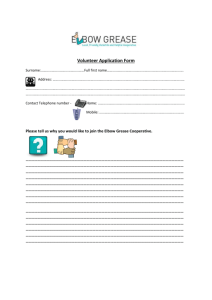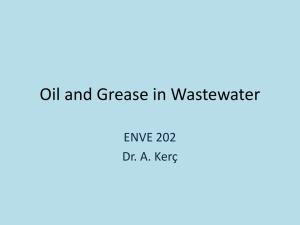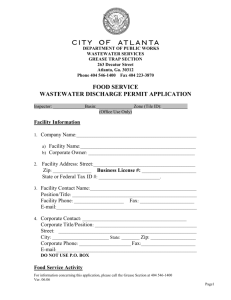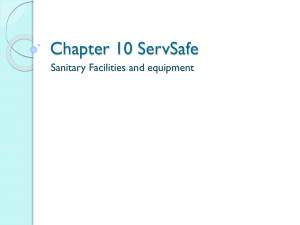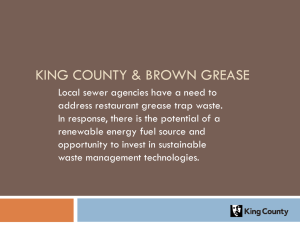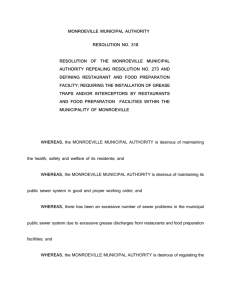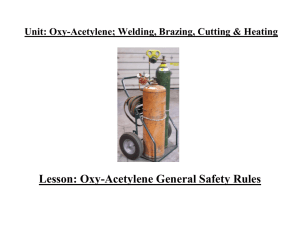GFT Wastewater-Grease Treatment Overview, 082411
advertisement
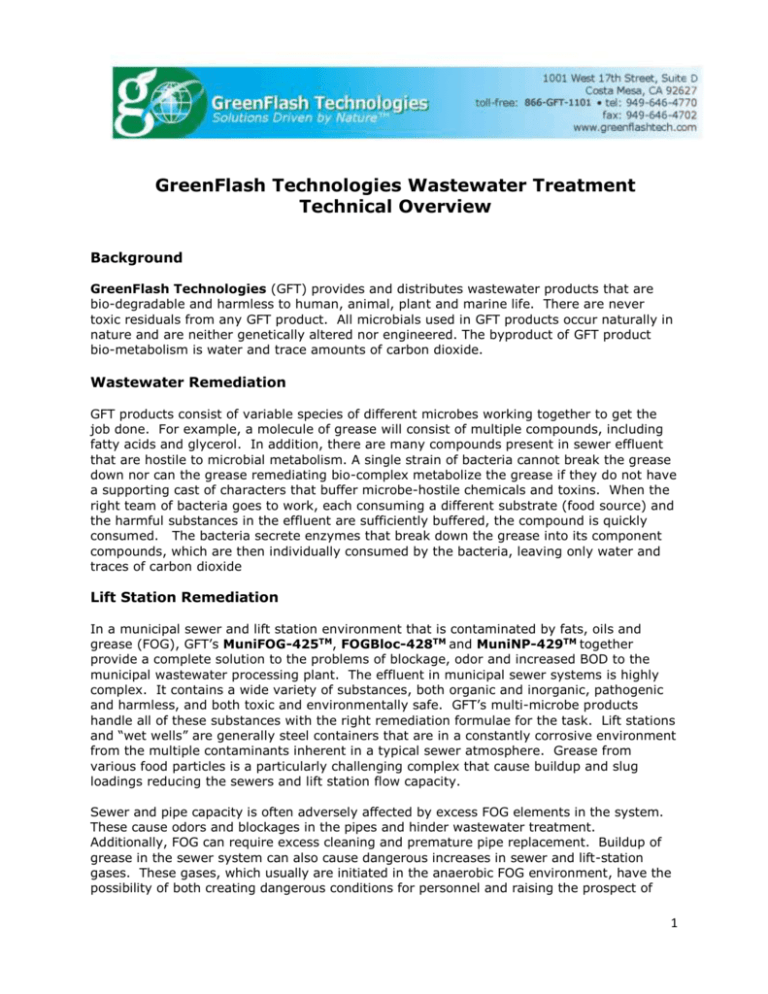
GreenFlash Technologies Wastewater Treatment Technical Overview Background GreenFlash Technologies (GFT) provides and distributes wastewater products that are bio-degradable and harmless to human, animal, plant and marine life. There are never toxic residuals from any GFT product. All microbials used in GFT products occur naturally in nature and are neither genetically altered nor engineered. The byproduct of GFT product bio-metabolism is water and trace amounts of carbon dioxide. Wastewater Remediation GFT products consist of variable species of different microbes working together to get the job done. For example, a molecule of grease will consist of multiple compounds, including fatty acids and glycerol. In addition, there are many compounds present in sewer effluent that are hostile to microbial metabolism. A single strain of bacteria cannot break the grease down nor can the grease remediating bio-complex metabolize the grease if they do not have a supporting cast of characters that buffer microbe-hostile chemicals and toxins. When the right team of bacteria goes to work, each consuming a different substrate (food source) and the harmful substances in the effluent are sufficiently buffered, the compound is quickly consumed. The bacteria secrete enzymes that break down the grease into its component compounds, which are then individually consumed by the bacteria, leaving only water and traces of carbon dioxide Lift Station Remediation In a municipal sewer and lift station environment that is contaminated by fats, oils and grease (FOG), GFT’s MuniFOG-425TM, FOGBloc-428TM and MuniNP-429TM together provide a complete solution to the problems of blockage, odor and increased BOD to the municipal wastewater processing plant. The effluent in municipal sewer systems is highly complex. It contains a wide variety of substances, both organic and inorganic, pathogenic and harmless, and both toxic and environmentally safe. GFT’s multi-microbe products handle all of these substances with the right remediation formulae for the task. Lift stations and “wet wells” are generally steel containers that are in a constantly corrosive environment from the multiple contaminants inherent in a typical sewer atmosphere. Grease from various food particles is a particularly challenging complex that cause buildup and slug loadings reducing the sewers and lift station flow capacity. Sewer and pipe capacity is often adversely affected by excess FOG elements in the system. These cause odors and blockages in the pipes and hinder wastewater treatment. Additionally, FOG can require excess cleaning and premature pipe replacement. Buildup of grease in the sewer system can also cause dangerous increases in sewer and lift-station gases. These gases, which usually are initiated in the anaerobic FOG environment, have the possibility of both creating dangerous conditions for personnel and raising the prospect of 1 underground explosions. Elimination of the root causes of the FOG is the best protection against these possible scenarios. Continuous treatment of the sewer and lift station environments with products employing both aerobic and anaerobic microbes to eliminate the FOG components are the best defense for the sewer system. The MuniFOG-425TM / FOGBloC-428TM bio-complex works equally well in low oxygen, facultative and aerobic degradation environments. Indigenous bacteria are present everywhere in the world, in the air, in the lakes and oceans, in the soil and are nature’s recyclers. They clean up the environment and keep it clean. The problem occurs when there are too many organic contaminants in an environment for the indigenous bacteria to consume (degrade). This is what occurs in wastewater systems when the volume of organic waste far overwhelms the number and types of indigenous waste degrading bacteria available in the sewer. That’s where GFT’s unique product design comes into play. Working with the indigenous bacteria already present in the wastewater system, the GFT product biocultures provide the proper types of selectively adapted microbials in sufficient numbers to biodegrade the organics and keep the wastewater system functioning properly. Sewer Control Process When placed in the sewer, MuniFOG-425TM bacteria build a biological “slime” on the pipe wall. The slime is the same thing you get on the media of a trickling filter in a sewer treatment plant. It can also be compared to the slime on a stone picked up in a creek. The bacteria will make the pipe wall too slippery for grease to attach to. In addition, these bugs “eat” the grease they come in contact with. As long as they have water, oxygen and a food source, these microbials multiply every 20 minutes. In other words, they continue to multiply in the sewer, forming every new and hungry “offspring” to keep eating away at the grease and other targeted organic contaminants. Sewer grease is at the bottom of their food chain. Its environment contains all varieties of noxious chemicals, soaps, petroleum byproducts, cellulose and toxic compounds. There is no bacterium that prefers sewer grease. Most bacteria would rather eat carbohydrates (sugars, starches and celluloses) first. Next they will choose protein. After all that is gone, there will work on the fats and grease that are easiest to break down. These are the greases and oil from restaurants – high quality grease from cooked food. Many strains of bacteria will not eat sewer grease under any circumstances. They simply die off if other nutrients are not available. The only effective sewage treatment formula is one that will eat sewer grease after all other food sources are gone. Thus an effective sewer formula requires a carefully selected mix of microbes. GFT sewer products contain bio-complexes of microbial strains that consume sewer grease. Used as directed, MuniFOG-425TM and FOGBLOC-428TM will work every time. Bacterial colonization of GFT bio-complex products requires the presence of suitable organic carbon, and of inorganically or organically bound nitrogen and phosphate. Bacteria use organic material for growth. They obtain it from dissolved organic substances in the effluent or from the particles to which they attach themselves. Bacteria also need nitrogen and phosphate for growth. They extract this from the organic material on which they grow. Bacterial growth (colonization) is limited by the supply of organic material. If this limitation is removed by the addition of organic material nitrogen and phosphate, growth will be stimulated. During bacterial growth, part of the organic food is used as energy and, as part of the metabolic process, is broken down into carbon dioxide and water. GFT’s MuniNP- 2 429TM provides buffered sources of nitrogen and phosphate to stimulate the microbes’ colonization and assure that they have a continuous energy source for their growth. The MuniFOG-425TM formula contain additional bacterial strains which will colonize in low oxygen facultative degradation environments, compounds for degradation of FOG compounds, detergents and surfactants, strains for degradation of phenolic and other aromatic compounds, cellulosic waste degraders, hydrocarbon and wax degraders, sulfide and noxious odor reduction and the breakdown of starches, sugars and other carbohydrates. Any material other than the above will not be affected by the bio-complex products and will remain after treatment. FOGBloc-428TM, which contains many of the same components, adds the benefit of long-lasting treatment, as the bloc slowly dissolves in the high-flow rate sewer/lift-station environments. Grease Interceptors Commercial buildings such as restaurants, hotel kitchens and bars, factory cafeterias and restaurants, clubs, processing plants and the like must have a grease interceptor or trap to accumulate grease that might otherwise clog the waste lines. When required, a separate waste line is installed to serve pot, scullery, food scrap and vegetable preparation sinks. Floor drains that may receive kitchen waste spillage and floor drains that may receive waste from individual fixtures, appliances or other apparatus must go through an approved grease interceptor. Grease interceptors (aka, traps) are designed to separate solids and liquids. Effluent enters the trap by the inflow pipe from the kitchen or area where grease originates. Heavy solid waste sinks to the bottom while grease and other lighter wastes float on top. Larger interceptors are multi-chamber where only the last chamber empties into the sewer system Baffles in the grease trap hold the lighter waste for easy cleaning. The remaining separated liquid flows out the outflow pipe into the sewer system. Grease traps come in different sizes and shapes. The size is based on the gallon capacity the grease trap can hold. The larger the trap capacity, the more retention time grease trap effluent will have in the trap and the more time the bacteria in the trap will have to degrade the grease, oil and suspended solids in the effluent. The GreenFlash Technologies Grease Remediation Process consists of four products, DrainSaver-423™, FOGX-427TM, FogBloc-428TM, and MuniNP-429TM. These products are used together to treat the grease trap and drains leading to the trap. While not all installations may need all of the products, most larger institutions will normally benefit from each of the products. FogBloc-428TM and MuniNP-429TM operate the same way as in the sewer or lift-station, providing time-released bacteria into the grease trap and adding the nutrients needed to enhance the remediation process. The amount of each required will be substantially less. The main constituents of these products are microbial bio-complexes (principally natural bacteria); enzymes to enhance the biological reactions plus surfactants to aid the cleansing process and maintain the bioremediation action. Multiple microbials are employed to address all of the potential grease and fat contaminants in the trap. The products are formulated to rapidly bio-degrade grease, oils and organic solids in grease traps and significantly deodorize the effluent within the traps and drains leading to the traps. The grease and fat contaminants are totally eliminated and cannot re-form in the trap or in the sewer system. 3 Once FOGX-427™ is applied to a grease trap, under normal circumstances, it should seldom have to be pumped, usually only to remove non-biodegradable trash from the trap such as plastic, metal objects, glassware, rags, bones, etc. Once applied, FOGX-427™ will immediately start to grow colonies of bacteria on the walls, baffles, and the top and bottom of the grease trap. Colonies will also start to grow on the grease crust itself. One of the principal advantages of treatment with FOGX-427™ is that it will clean the entire grease trap. The average grease trap will require about 2 - 4 weeks to bring "under control" depending on trap capacity and volume into the trap. DrainSaver-423™ adds the dimension of cleaning the drains leading to the trap, particularly those that handle most of the grease. Putting a couple of ounces of DrainSaver-423™ into each drain will keep the drains running feely and help alleviate odors emanating from decaying grease molecules remaining in the drains. There should always be some grease floating on top of the water in a grease trap. This is the grease recently drained into the trap that the bacteria have not had a chance to digest. The grease crust will usually stay about 1 to 3 inches thick. This is expected and required for normal operation of the trap. Together, the GFT Grease Remediation Process will provide a total grease trap solution for the restaurant, dormitory, market or any other eating or food preparation establishment. Continuous treatment with these products will provide the assurance that odors will be eliminated from the traps and drains, and that the FOG elements entering the trap will not be transferred to the municipal sewer and left-station environment. 4
